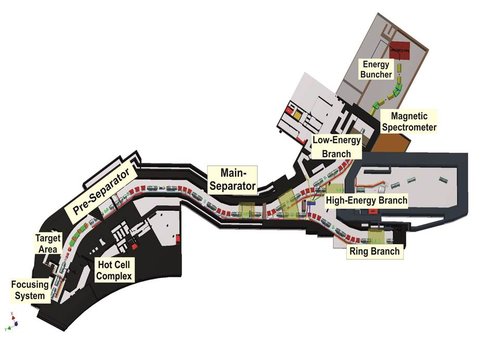The Super-FRS machine
The Super-FRS is a two-stage fragment separator that consists of a pre-separator and a main separator. Both separator stages use the Bρ-ΔE-Bρ method, in which the analysis of the magnetic rigidity (Bρ) is combined with the energy loss in a specially shaped degrader (ΔE). The main separator has three possible exits, to the ring branch (RB), to the high-energy branch (HEB) and to the low-energy branch (LEB), to which a dedicated magnetic-spectrometer/energy-buncher-system is connected. The Super-FRS is characterized by a large phase-space acceptance, which is made possible by the use of superconducting magnet technology.
The high radiation exposure in the target area requires a special design. In the highly shielded area are located both the high-performance production-target and the beam-catcher systems. The latter get rids of the primary beam that did not react in the production-target. The components in target area must be handled remotely. The maintenance work is carried out in a hot cell complex that is integrated in the Super-FRS target building.
Dedicated detector systems allow a complete identification of the fragments and provide this information on an event-by-event basis to the integrated experiments.
Here you can find an overview of the technical properties.
Here you can find an overview of the Super-FRS components.
The existing FRS is the benching platform for the development of the Super FRS.
For internal users here the link to the
Super-FRS Wiki (as part of the NUSTAR-Wiki)
Super-FRS cloud (common Seafile-Storage place)







